2023届高三英语二轮复习:2023年高考英语新课标新教材新高考新题破解之道课件-(58张ppt)
文档属性
| 名称 | 2023届高三英语二轮复习:2023年高考英语新课标新教材新高考新题破解之道课件-(58张ppt) |  | |
| 格式 | zip | ||
| 文件大小 | 10.3MB | ||
| 资源类型 | 教案 | ||
| 版本资源 | 通用版 | ||
| 科目 | 英语 | ||
| 更新时间 | 2022-12-21 09:33:06 | ||
图片预览

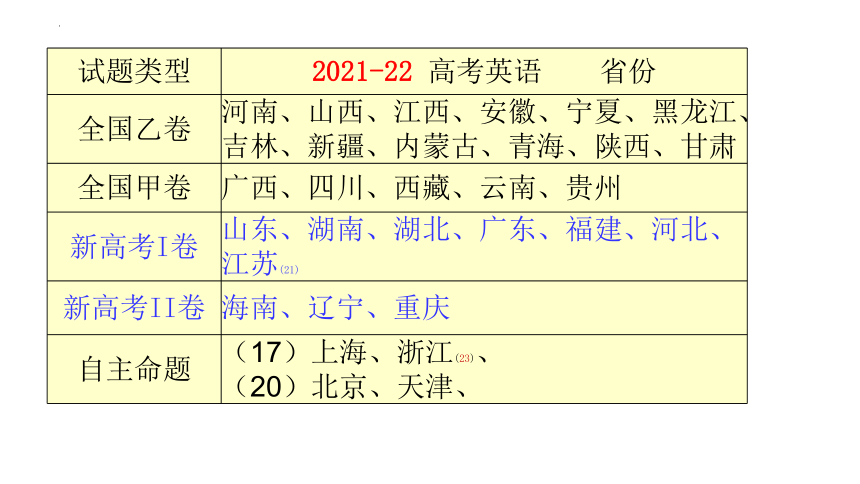



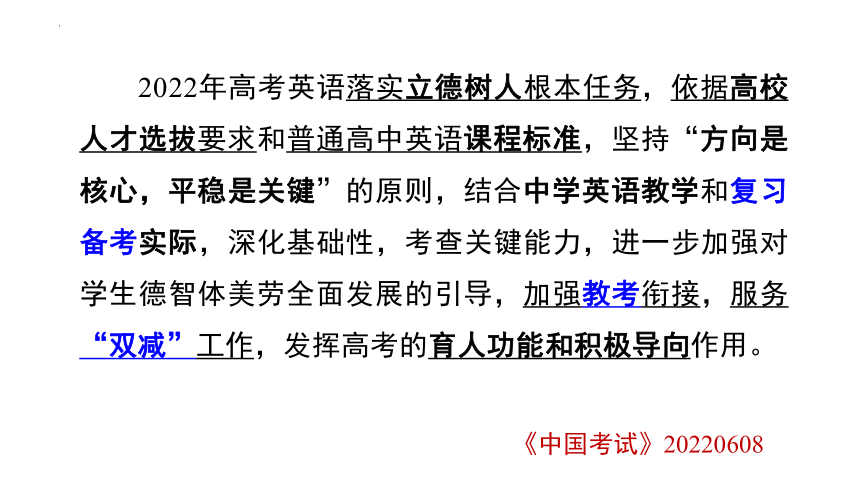
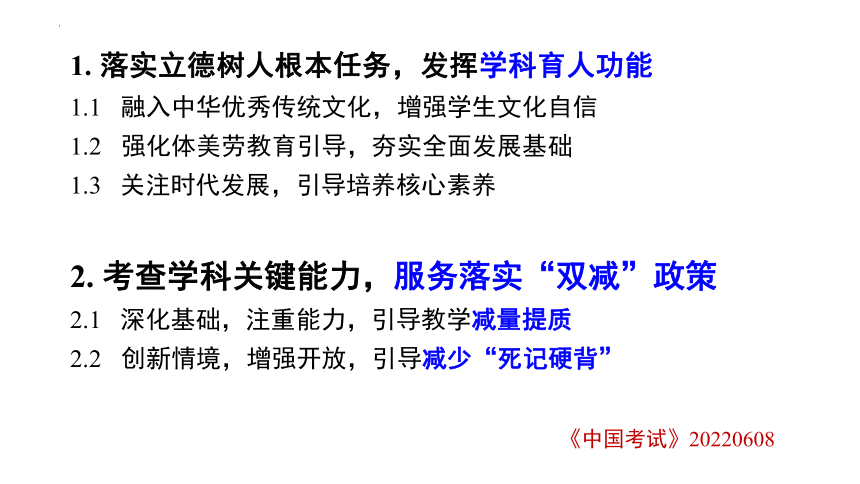
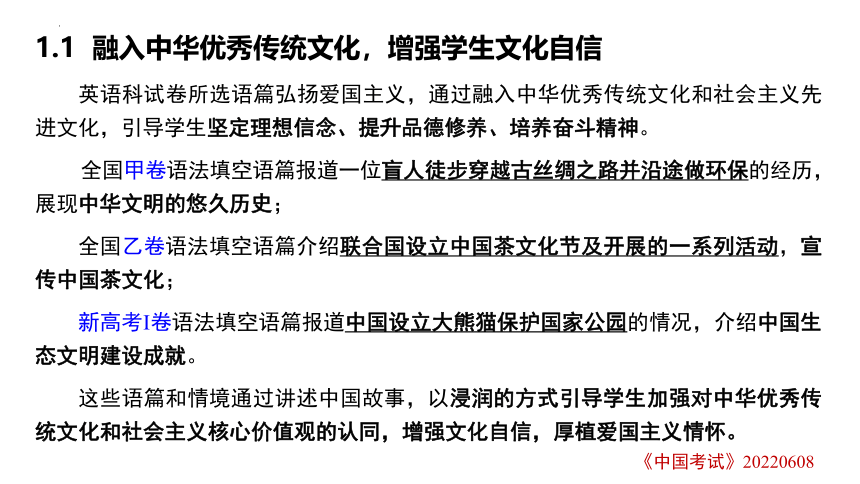
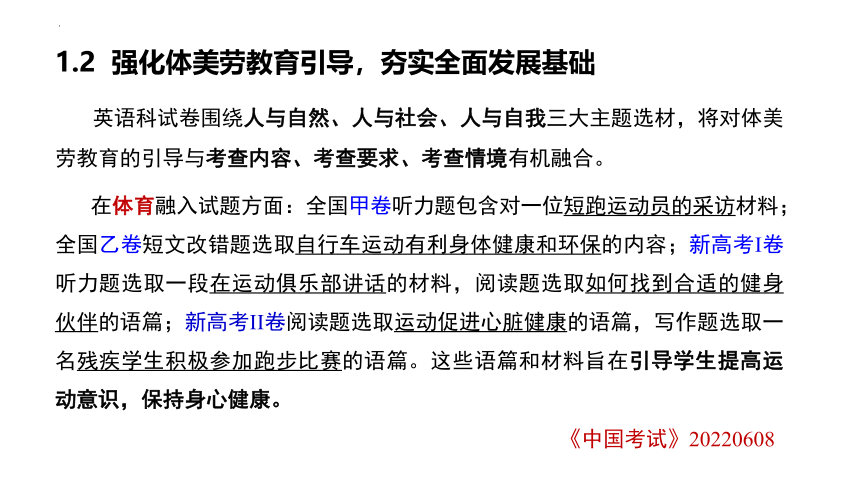
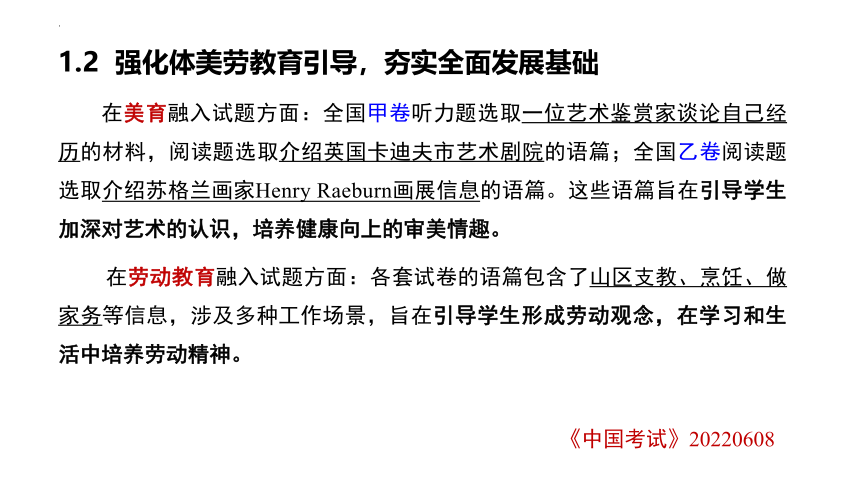
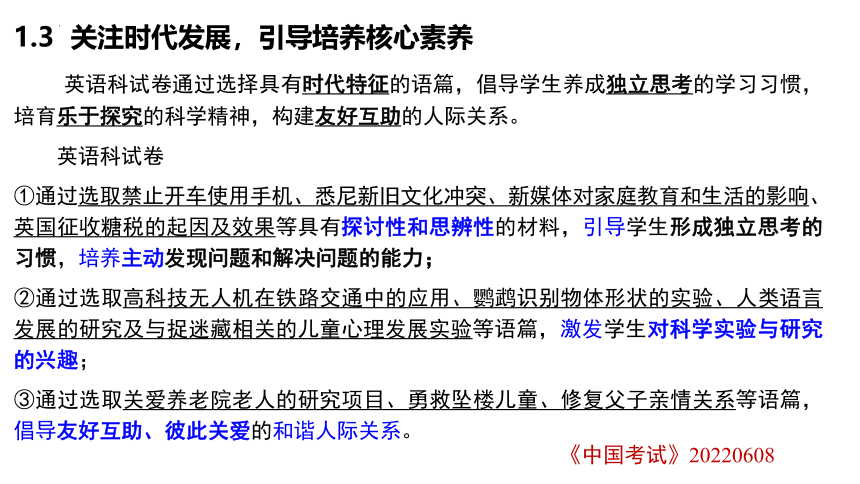
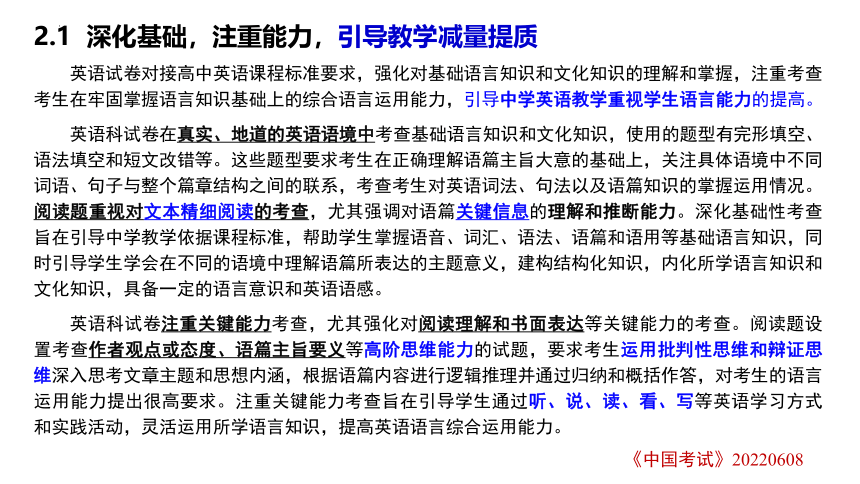
文档简介
(共58张PPT)
新课标新教材新高考的
新题破解之道
试题类型 2021-22 高考英语 省份
全国乙卷 河南、山西、江西、安徽、宁夏、黑龙江、吉林、新疆、内蒙古、青海、陕西、甘肃
全国甲卷 广西、四川、西藏、云南、贵州
新高考I卷 山东、湖南、湖北、广东、福建、河北、江苏(21)
新高考II卷 海南、辽宁、重庆
自主命题 (17)上海、浙江(23)、
(20)北京、天津、
北京中高考改革
2017届初中:语数外300分,理、化生、史地政2+1 3/5;
英语:100分 = 听+说 40分,卷面60分;
2017年:高考听力机考2次/年,占30分,卷面120分;
2021年:150分 =听+说 50分, 卷面100分;
2022/12/21
高考英语试卷整体难度0.55左右,能够在较大程度上发挥为高校选拔人才的作用。
备考策略
难度比例
3: 5: 2
保八争二
35
8-10
10-12
45
内容 节 题量 计分 时间
第一部分 听力理解 一 5 7.5
20
二 15 22.5
第二部分 阅读理解 一 15 37.5
100
二 5 12.5
第三部分 语言知识运用 一 15(完形) 15
二 10 15
第四部分 写作 一 1 15
二 1(续写) 25
总计 65+2 150 120
新高考
时间分配
答题顺序
总体设计
2022年高考英语落实立德树人根本任务,依据高校人才选拔要求和普通高中英语课程标准,坚持“方向是核心,平稳是关键”的原则,结合中学英语教学和复习备考实际,深化基础性,考查关键能力,进一步加强对学生德智体美劳全面发展的引导,加强教考衔接,服务“双减”工作,发挥高考的育人功能和积极导向作用。
《中国考试》20220608
1. 落实立德树人根本任务,发挥学科育人功能
1.1 融入中华优秀传统文化,增强学生文化自信
1.2 强化体美劳教育引导,夯实全面发展基础
1.3 关注时代发展,引导培养核心素养
2. 考查学科关键能力,服务落实“双减”政策
2.1 深化基础,注重能力,引导教学减量提质
2.2 创新情境,增强开放,引导减少“死记硬背”
《中国考试》20220608
1.1 融入中华优秀传统文化,增强学生文化自信
英语科试卷所选语篇弘扬爱国主义,通过融入中华优秀传统文化和社会主义先进文化,引导学生坚定理想信念、提升品德修养、培养奋斗精神。
全国甲卷语法填空语篇报道一位盲人徒步穿越古丝绸之路并沿途做环保的经历,展现中华文明的悠久历史;
全国乙卷语法填空语篇介绍联合国设立中国茶文化节及开展的一系列活动,宣传中国茶文化;
新高考I卷语法填空语篇报道中国设立大熊猫保护国家公园的情况,介绍中国生态文明建设成就。
这些语篇和情境通过讲述中国故事,以浸润的方式引导学生加强对中华优秀传统文化和社会主义核心价值观的认同,增强文化自信,厚植爱国主义情怀。
《中国考试》20220608
1.2 强化体美劳教育引导,夯实全面发展基础
英语科试卷围绕人与自然、人与社会、人与自我三大主题选材,将对体美劳教育的引导与考查内容、考查要求、考查情境有机融合。
在体育融入试题方面:全国甲卷听力题包含对一位短跑运动员的采访材料;全国乙卷短文改错题选取自行车运动有利身体健康和环保的内容;新高考I卷听力题选取一段在运动俱乐部讲话的材料,阅读题选取如何找到合适的健身伙伴的语篇;新高考II卷阅读题选取运动促进心脏健康的语篇,写作题选取一名残疾学生积极参加跑步比赛的语篇。这些语篇和材料旨在引导学生提高运动意识,保持身心健康。
《中国考试》20220608
1.2 强化体美劳教育引导,夯实全面发展基础
在美育融入试题方面:全国甲卷听力题选取一位艺术鉴赏家谈论自己经历的材料,阅读题选取介绍英国卡迪夫市艺术剧院的语篇;全国乙卷阅读题选取介绍苏格兰画家Henry Raeburn画展信息的语篇。这些语篇旨在引导学生加深对艺术的认识,培养健康向上的审美情趣。
在劳动教育融入试题方面:各套试卷的语篇包含了山区支教、烹饪、做家务等信息,涉及多种工作场景,旨在引导学生形成劳动观念,在学习和生活中培养劳动精神。
《中国考试》20220608
1.3 关注时代发展,引导培养核心素养
英语科试卷通过选择具有时代特征的语篇,倡导学生养成独立思考的学习习惯,培育乐于探究的科学精神,构建友好互助的人际关系。
英语科试卷
①通过选取禁止开车使用手机、悉尼新旧文化冲突、新媒体对家庭教育和生活的影响、英国征收糖税的起因及效果等具有探讨性和思辨性的材料,引导学生形成独立思考的习惯,培养主动发现问题和解决问题的能力;
②通过选取高科技无人机在铁路交通中的应用、鹦鹉识别物体形状的实验、人类语言发展的研究及与捉迷藏相关的儿童心理发展实验等语篇,激发学生对科学实验与研究的兴趣;
③通过选取关爱养老院老人的研究项目、勇救坠楼儿童、修复父子亲情关系等语篇,倡导友好互助、彼此关爱的和谐人际关系。
《中国考试》20220608
2.1 深化基础,注重能力,引导教学减量提质
英语试卷对接高中英语课程标准要求,强化对基础语言知识和文化知识的理解和掌握,注重考查考生在牢固掌握语言知识基础上的综合语言运用能力,引导中学英语教学重视学生语言能力的提高。
英语科试卷在真实、地道的英语语境中考查基础语言知识和文化知识,使用的题型有完形填空、语法填空和短文改错等。这些题型要求考生在正确理解语篇主旨大意的基础上,关注具体语境中不同词语、句子与整个篇章结构之间的联系,考查考生对英语词法、句法以及语篇知识的掌握运用情况。阅读题重视对文本精细阅读的考查,尤其强调对语篇关键信息的理解和推断能力。深化基础性考查旨在引导中学教学依据课程标准,帮助学生掌握语音、词汇、语法、语篇和语用等基础语言知识,同时引导学生学会在不同的语境中理解语篇所表达的主题意义,建构结构化知识,内化所学语言知识和文化知识,具备一定的语言意识和英语语感。
英语科试卷注重关键能力考查,尤其强化对阅读理解和书面表达等关键能力的考查。阅读题设置考查作者观点或态度、语篇主旨要义等高阶思维能力的试题,要求考生运用批判性思维和辩证思维深入思考文章主题和思想内涵,根据语篇内容进行逻辑推理并通过归纳和概括作答,对考生的语言运用能力提出很高要求。注重关键能力考查旨在引导学生通过听、说、读、看、写等英语学习方式和实践活动,灵活运用所学语言知识,提高英语语言综合运用能力。
《中国考试》20220608
2.2 创新情境,增强开放,引导减少“死记硬背”
英语科试卷在听力、阅读、语言运用和写作等各部分根据所选素材创设不同的生活实践情境和学习探索情境;通过增强试题开放性和灵活性考查考生运用语言的能力,引导减少“死记硬背”。
2022年高考英语试卷进一步优化写作等试题的考查形式。除考查写邮件等常见形式外,写作部分还设置了读图表写短文和根据提纲要点写短文等形式。
《中国考试》20220608
2.2 创新情境,增强开放,引导减少“死记硬背”
全国甲卷要求考生以6月8日世界海洋日为主题,写一篇短文向学校征文比赛投稿;
全国乙卷设置的写作情境是校英文报正在开展以Learning English beyond the Classroom为题的讨论,要求考生阅读有关学生英语学习活动情况的图表,使用图表中的调查结果写一篇短文;
新高考卷应用文设置的情境是以校广播站英语节目“Talk and Talk”负责人的身份给外教写一封邮件,邀请她做一次访谈;
新高考卷短文续写试题设置的情境是阅读一名残疾学生坚持参加跑步比赛的短文后续写两段文字。
《中国考试》20220608
2.2 创新情境,增强开放,引导减少“死记硬背”
这些精心设计的试题情境使写作形式更加灵活,内容更加开放,在加强语言表达能力考查的同时,强调对应用性和创造性能力的考查,引导学生在语言学习过程中注重辨析语言和文化中的具体现象,梳理和概括信息,从自己的视角正确评判周围事物和不同观念,创造性地表达自己的观点和想法。
《中国考试》20220608
阅读理解命题赏析
2022新1卷
22-N-1-A
Grading Policies for Introduction to Literature
Grading Scale
90-100, A; 80-89, B; 70-79, C; 60-69, D; Below 60, E.
Essays (60%)
Your four major essays will combine to form the main part of the grade for this course: Essay 1 = 10%; Essay 2-15%; Essay 3= 15%; Essay 4 = 20%.
Group Assignments (30%)
Students will work in groups to complete four assignments (作业) during the course. All the assignments will be submitted by the assigned date through Blackboard, our online learning and course management system.
Daily Work/In-Class Writings and Test/Group Work/Homework (10%)
Class activities will vary from day to day, but students must be ready to complete short in-class writings or tests drawn directly from assigned readings or notes from the previous class’ lecture/discussion, so it is important to take careful notes during class. Additionally, from time to time I will assign group work to be completed in class or short assignments to be completed at home, both of which will be graded.
Late Work
An essay not submitted in class on the due date will lose a letter grade for each class period it is late. If it is not turned in by the 4th day after the due date, it will earn a zero. Daily assignments not completed during class will get a zero. Short writings missed as a result of an excused absence will be accepted.
22-N-1-A
21. Where is this text probably taken from ④
A. A textbook. B. An exam paper.
C. A course plan. D. An academic article.
22. How many parts is a student’s final grade made up of ②+
A. Two. B. Three. C. Four. D. Five.
23. What will happen if you submit an essay one week after the due date ②+
A. You will receive a zero. B. You will lose a letter grade.
C. You will be given a test. D. You will have to rewrite it.
22-N-1-A
Grading Policies for Introduction to Literature
Grading Scale
90-100, A; 80-89, B; 70-79, C; 60-69, D; Below 60, E.
Essays (60%)
Your four major essays will combine to form the main part of the grade for this course: Essay 1 = 10%; Essay 2-15%; Essay 3= 15%; Essay 4 = 20%.
Group Assignments (30%)
Students will work in groups to complete four assignments (作业) during the course. All the assignments will be submitted by the assigned date through Blackboard, our online learning and course management system.
Daily Work/In-Class Writings and Test/Group Work/Homework (10%)
Class activities will vary from day to day, but students must be ready to complete short in-class writings or tests drawn directly from assigned readings or notes from the previous class’ lecture/discussion, so it is important to take careful notes during class. Additionally, from time to time I will assign group work to be completed in class or short assignments to be completed at home, both of which will be graded.
Late Work
An essay not submitted in class on the due date will lose a letter grade for each class period it is late. If it is not turned in by the 4th day after the due date, it will earn a zero. Daily assignments not completed during class will get a zero. Short writings missed as a result of an excused absence will be accepted.
21
22
23
22-N-1-B
Like most of us, I try to be mindful of food that goes to waste. The arugula (芝麻菜) was to make a nice green salad, rounding out a roast chicken dinner. But I ended up working late. Then friends called with a dinner invitation. I stuck the chicken in the freezer. But as days passed, the arugula went bad. Even worse, I had unthinkingly bought way too much; I could have made six salads with what I threw out.
In a world where nearly 800 million people a year go hungry, “food waste goes against the moral grain,” as Elizabeth Royte writes in this month’s cover story. It’s jaw-dropping how much perfectly good food is thrown away - from “ugly” (but quite eatable) vegetables rejected by grocers to large amounts of uneaten dishes thrown into restaurant garbage cans.
Producing food that no one eats wastes the water, fuel, and other resources used to grow it. That makes food waste an environmental problem. In fact, Royte writes, “if food waste were a country, it would be the third largest producer of greenhouse gases in the world.”
If that’s hard to understand, let’s keep it as simple as the arugula at the back of my refrigerator. Mike Curtin sees my arugula story all the time - but for him, it’s more like 12 boxes of donated strawberries nearing their last days. Curtin is CEO of DC Central Kitchen in Washington. D.C., which recovers food and turns it into healthy meals. Last year it recovered more than 807,500 pounds of food by taking donations and collecting blemished (有瑕疵的) produce that otherwise would have rotted in fields. And the strawberries Volunteers will wash, cut, and freeze or dry them for use in meals down the road.
Such methods seem obvious, yet so often we just don’t think. “Everyone can play a part in reducing waste, whether by not purchasing more food than necessary in your weekly shopping or by asking restaurants to not include the side dish you won’t eat.” Curtin says.
22-N-1-B
24. What does the author want to show by telling the arugula story ④
A. We pay little attention to food waste. B. We waste food unintentionally at times.
C. We waste more vegetables than meat. D. We have good reasons for wasting food.
25. What is a consequence of food waste according to the text ②+
A. Moral decline. B. Environmental harm.
C. Energy shortage. D. Worldwide starvation.
26. What does Curtin’s company do ②+
A. It produces kitchen equipment. B. It turns rotten arugula into clean fuel.
C. It helps local farmers grow fruits. D. It makes meals out of unwanted food.
27. What does Curtin suggest people do ④
A. Buy only what is needed. B. Reduce food consumption.
C. Go shopping once a week. D. Eat in restaurants less often.
22-N-1-B
Like most of us, I try to be mindful of food that goes to waste. The arugula (芝麻菜) was to make a nice green salad, rounding out a roast chicken dinner. But I ended up working late. Then friends called with a dinner invitation. I stuck the chicken in the freezer. But as days passed, the arugula went bad. Even worse, I had unthinkingly bought way too much; I could have made six salads with what I threw out.
In a world where nearly 800 million people a year go hungry, “food waste goes against the moral grain,” as Elizabeth Royte writes in this month’s cover story. It’s jaw-dropping how much perfectly good food is thrown away - from “ugly” (but quite eatable) vegetables rejected by grocers to large amounts of uneaten dishes thrown into restaurant garbage cans.
Producing food that no one eats wastes the water, fuel, and other resources used to grow it. That makes food waste an environmental problem. In fact, Royte writes, “if food waste were a country, it would be the third largest producer of greenhouse gases in the world.”
If that’s hard to understand, let’s keep it as simple as the arugula at the back of my refrigerator. Mike Curtin sees my arugula story all the time - but for him, it’s more like 12 boxes of donated strawberries nearing their last days. Curtin is CEO of DC Central Kitchen in Washington. D.C., which recovers food and turns it into healthy meals. Last year it recovered more than 807,500 pounds of food by taking donations and collecting blemished (有瑕疵的) produce that otherwise would have rotted in fields. And the strawberries Volunteers will wash, cut, and freeze or dry them for use in meals down the road.
Such methods seem obvious, yet so often we just don’t think. “Everyone can play a part in reducing waste, whether by not purchasing more food than necessary in your weekly shopping or by asking restaurants to not include the side dish you won’t eat.” Curtin says.
25
24
26
27
22-N-1-B
24. What does the author want to show by telling the arugula story ④
A. We pay little attention to food waste. B. We waste food unintentionally at times.
C. We waste more vegetables than meat. D. We have good reasons for wasting food.
25. What is a consequence of food waste according to the text ②+
A. Moral decline. B. Environmental harm.
C. Energy shortage. D. Worldwide starvation.
26. What does Curtin’s company do ②+
A. It produces kitchen equipment. B. It turns rotten arugula into clean fuel.
C. It helps local farmers grow fruits. D. It makes meals out of unwanted food.
27. What does Curtin suggest people do ④
A. Buy only what is needed. B. Reduce food consumption.
C. Go shopping once a week. D. Eat in restaurants less often.
22-N-1-C
The elderly residents (居民) in care homes in London are being given hens to look after to stop them feeling lonely.
The project was dreamed up by a local charity to reduce loneliness and improve elderly people’s wellbeing. It is also being used to help patients suffering dementia, a serious illness of the mind. Staff in care homes have reported a reduction in the use of medicine where hens are in use.
Among those taking part in the project is 80-year-old Ruth Xavier. She said: “I used to keep hens when I was younger and had to prepare their breakfast each morning before I went to school.
“I like the project a lot. I am down there in my wheelchair in the morning letting the hens out and down there again at night to see they’ve gone to bed.”
“It’s good to have a different focus. People have been bringing their children in to see the hens and residents come and sit outside to watch them. I’m enjoying the creative activities, and it feels great to have done something useful.”
There are now 700 elderly people looking after hens in 20 care homes in the North East, and the charity has been given financial support to roll it out countrywide.
7)Wendy Wilson, extra care manager at 60 Penfold Street, one of the first to embark on the project, said: “Residents really welcome the idea of the project and the creative sessions. We are looking forward to the benefits and fun the project can bring to people here.”
8)Lynn Lewis, director of Notting Hill Pathways, said: “We are happy to be taking part in the project. It will really help connect our residents through a shared interest and creative activities.”
22-N-1-C
28. What is the purpose of the project ④
A. To ensure harmony in care homes. B. To provide part-time jobs for the aged.
C. To raise money for medical research. D. To promote the elderly people’s welfare.
29. How has the project affected Ruth Xavier ④
A. She has learned new life skills. B. She has gained a sense of achievement.
C. She has recovered her memory. D. She has developed a strong personality.
30. What do the underlined words “embark on” mean in paragraph 7 ③
A. Improve. B. Oppose. C. Begin. D. Evaluate.
31. What can we learn about the project from the last two paragraphs ④
A. It is well received. B. It needs to be more creative.
C. It is highly profitable. D. It takes ages to see the results.
22-N-1-C
The elderly residents (居民) in care homes in London are being given hens to look after to stop them feeling lonely.
The project was dreamed up by a local charity to reduce loneliness and improve elderly people’s wellbeing. It is also being used to help patients suffering dementia, a serious illness of the mind. Staff in care homes have reported a reduction in the use of medicine where hens are in use.
Among those taking part in the project is 80-year-old Ruth Xavier. She said: “I used to keep hens when I was younger and had to prepare their breakfast each morning before I went to school.
“I like the project a lot. I am down there in my wheelchair in the morning letting the hens out and down there again at night to see they’ve gone to bed.”
“It’s good to have a different focus. People have been bringing their children in to see the hens and residents come and sit outside to watch them. I’m enjoying the creative activities, and it feels great to have done something useful.”
There are now 700 elderly people looking after hens in 20 care homes in the North East, and the charity has been given financial support to roll it out countrywide.
7)Wendy Wilson, extra care manager at 60 Penfold Street, one of the first to embark on the project, said: “Residents really welcome the idea of the project and the creative sessions. We are looking forward to the benefits and fun the project can bring to people here.”
8)Lynn Lewis, director of Notting Hill Pathways, said: “We are happy to be taking part in the project. It will really help connect our residents through a shared interest and creative activities.”
294
311-
303
28 2+
22-N-1-C
28. What is the purpose of the project ④
A. To ensure harmony in care homes. B. To provide part-time jobs for the aged.
C. To raise money for medical research. D. To promote the elderly people’s welfare.
29. How has the project affected Ruth Xavier ④
A. She has learned new life skills. B. She has gained a sense of achievement.
C. She has recovered her memory. D. She has developed a strong personality.
30. What do the underlined words “embark on” mean in paragraph 7 ③
A. Improve. B. Oppose. C. Begin. D. Evaluate.
31. What can we learn about the project from the last two paragraphs ④
A. It is well received. B. It needs to be more creative.
C. It is highly profitable. D. It takes ages to see the results.
22-N-1-D
Human speech contains more than 2,000 different sounds, from the common “m” and “a” to the rare clicks of some southern African languages. But why are certain sounds more common than others A ground-breaking, five-year study shows that diet-related changes in human bite led to new speech sounds that are now found in half the world’s languages.
More than 30 years ago, the scholar Charles Hockett noted that speech sounds called labiodentals, such as “f” and “v”, were more common in the languages of societies that ate softer foods. Now a team of researchers led by Damián Blasi at the University of Zurich, Switzerland, has found how and why this trend arose.
They discovered that the upper and lower front teeth of ancient human adults were aligned (对齐), making it hard to produce labiodentals, which are formed by touching the lower lip to the upper teeth. Later, our jaws changed to an overbite structure (结构), making it easier to produce such sounds.
The team showed that this change in bite was connected with the development of agriculture in the Neolithic period. Food became easier to chew at this point. The jawbone didn’t have to do as much work and so didn’t grow to be so large.
5) Analyses of a language database also confirmed that there was a global change in the sound of world languages after the Neolithic age, with the use of “f” and “v” increasing remarkably during the last few thousand years. These sounds are still not found in the languages of many hunter-gatherer people today.
This research overturns the popular view that all human speech sounds were present when human beings evolved around 300,000 years ago. “The set of speech sounds we use has not necessarily remained stable since the appearance of human beings, but rather the huge variety of speech sounds that we find today is the product of a complex interplay of things like biological change and cultural evolution,” said Steven Moran, a member of the research team.
22-N-1-D
32. Which aspect of the human speech sound does Damián Blasi’s research focus on ②+
A. Its variety. B. Its distribution. C. Its quantity. D. Its development.
33. Why was it difficult for ancient human adults to produce labiodentals ②+
A. They had fewer upper teeth than lower teeth.
B. They could not open and close their lips easily.
C. Their jaws were not conveniently structured.
D. Their lower front teeth were not large enough.
34. What is paragraph 5 mainly about ①
A. Supporting evidence for the research results. B. Potential application of the research findings.
C. A further explanation of the research methods. D. A reasonable doubt about the research process.
35. What does Steven Moran say about the set of human speech sounds ④
A. It is key to effective communication. B. It contributes much to cultural diversity.
C. It is a complex and dynamic system. D. It drives the evolution of human beings.
22-N-1-D
Human speech contains more than 2,000 different sounds, from the common “m” and “a” to the rare clicks of some southern African languages. But why are certain sounds more common than others A ground-breaking, five-year study shows that diet-related changes in human bite led to new speech sounds that are now found in half the world’s languages.
More than 30 years ago, the scholar Charles Hockett noted that speech sounds called labiodentals, such as “f” and “v”, were more common in the languages of societies that ate softer foods. Now a team of researchers led by Damián Blasi at the University of Zurich, Switzerland, has found how and why this trend arose.
They discovered that the upper and lower front teeth of ancient human adults were aligned (对齐), making it hard to produce labiodentals, which are formed by touching the lower lip to the upper teeth. Later, our jaws changed to an overbite structure (结构), making it easier to produce such sounds.
The team showed that this change in bite was connected with the development of agriculture in the Neolithic period. Food became easier to chew at this point. The jawbone didn’t have to do as much work and so didn’t grow to be so large.
5) Analyses of a language database also confirmed that there was a global change in the sound of world languages after the Neolithic age, with the use of “f” and “v” increasing remarkably during the last few thousand years. These sounds are still not found in the languages of many hunter-gatherer people today.
This research overturns the popular view that all human speech sounds were present when human beings evolved around 300,000 years ago. “The set of speech sounds we use has not necessarily remained stable since the appearance of human beings, but rather the huge variety of speech sounds that we find today is the product of a complex interplay of things like biological change and cultural evolution,” said Steven Moran, a member of the research team.
322+
332+
341-
354
2021新高考I
试题+命题分析
Rome can be pricey for travelers, which is why many choose to stay in a hostel(旅社). The hostels in Rome offer bed in dorm room for around $25 a night, and for that, you'll often get to stay in a central location with security and comfort.
Yellow Hostel
If I had to make just one recommendation for where to stay in Rome, it would be Yellow Hostel. It's one of the best-rated hostels in the city, and for good reason. It's affordable, and it's got a fun atmosphere without being too noisy. As an added bonus, it's close to the main train station.
Hostel Alessandro Palace
If you love social hostels, this is the best hostel for you in Rome. Hostel Alessandro Palace is fun. Staff members hold plenty of bar events for guests like free shots, bar crawls and karaoke. There's also an area on the rooftop for hanging out with other travelers during the summer.
Youth Station Hostel
If you're looking for cleanliness and a modern hostel, look no further than Youth Station. It offers beautiful furnishings and beds. There are plenty of other benefits, too; it doesn't charge city tax; it has both air conditioning and a heater for the rooms; it also has free Wi-Fi in every room.
Hotel and Hostel Des Artistes
Hotel and Hostel Des Artistes is located just a 10-minute walk from the central city station and it's close to all of the city's main attractions. The staff is friendly and helpful, providing you with a map of the city when you arrive, and offering advice if you require some. However, you need to pay 2 euros a day for Wi-Fi.
21
23
22
命题?
2021新高考I-A
By day, Robert Titterton is a lawyer. In his spare time though he goes on stage beside pianist Maria Raspopova -not as a musician but as her page turner. "I'm not a trained musician, but I've learnt to read music so I can help Maria in her performance."
Mr Titterton is chairman of the Omega Ensemble but has been the group's official page turner for the past four years. His job is to sit beside the pianist and turn the pages of the score so the musician doesn't have to break the flow of sound by doing it themselves. He said he became just as nervous as those playing instruments on stage.
"A lot of skills are needed for the job. You have to make sure you don't turn two pages at once and make sure you find the repeats in the music when you have to go back to the right spot." Mr Titterton explained. Being a page turner requires plenty of practice. Some pieces of music can go for 40 minutes and require up to 50 page turns, including back turns for repeat passages. Silent onstage communication is key, and each pianist has their own style of "nodding" to indicate a page turn which they need to practise with their page turner.
But like all performances, there are moments when things go wrong. "I was turning the page to get ready for the next page, but the draft wind from the turn caused the spare pages to fall off the stand, Mr Titterton said, "Luckily I was able to catch them and put them back."
Most page turners are piano students or up-and-coming concert pianists, although Ms Raspopova has once asked her husband to help her out on stage.
"My husband is the worst page turner," she laughed. "He's interested in the music, feeling every note, and I have to say: Turn, turn!'" Robert is the best page turner I've' had in my entire life”.(327)
24
25
26
27
话题?命题?
2021新高考I-B
When the explorers first set foot upon the continent of North America, the skies and lands were alive with an astonishing variety of wildlife. Native Americans had taken care of these precious natural resources wisely. Unfortunately, it took the explorers and the settlers who followed only a few decades to decimate a large part of these resources. Millions of waterfowl were killed at the hands of market hunters and a handful of overly ambitious sportsmen. Millions of acres of wetlands were dried to feed and house the ever-increasing- populations, greatly reducing waterfowl habitat(栖息地).
In 1934, with the passage of the Migratory Bird Hunting Stamp Act (Act), an increasingly concerned nation took firm action to stop the destruction of migratory(迁徙的) waterfowl and the wetlands so vital to their survival. Under this Act, all waterfowl hunters 16 years of age and over must annually purchase and carry a Federal Duck Stamp. The very first Federal Duck Stamp was designed by J.N. "Ding" Darling, a political cartoonist from Des Moines, Iowa, who at that time was appointed by President Franklin Roosevelt as Director of the Bureau of Biological Survey. Hunters willingly pay the stamp price to ensure the survival of our natural resources.
About 98 cents of every duck stamp dollar goes directly into the Migratory Bird Conservation Fund to purchase wetlands and wildlife habitat for inclusion into the National Wildlife Refuge System-a fact that ensures this land will be protected and available for all generations to come. Since 1934, better than half a billion dollars has gone into that Fund to purchase more than 5 million acres of habitat. Little wonder the Federal Duck Stamp Program has been called one of the most successful conservation programs ever initiated. (294)
28
29
30
31
命题布局?
2021新高考I-C
Popularization has in some cases changed the original meaning of emotional(情感的) intelligence. Many people now misunderstand emotional intelligence as almost everything desirable in a person's makeup that cannot be measured by an IQ test, such as character, motivation, confidence, mentals, stability, optimism and "people skills." Research has shown that emotional skills may contribute to some of these qualities, but most of them move far beyond skill-based emotional intelligence.
2)We prefer to describe emotional intelligence as a specific set of skills that can be used for either good or bad purposes. The ability to accurately understand how others are feeling may be used by a doctor to find how best to help her patients, while a cheater might use it to control potential victims. Being emotionally intelligent does not necessarily make one a moral person.
Although popular beliefs regarding emotional intelligence run far ahead of what research can reasonably support, the overall effects of the publicity have been more beneficial than harmful. The most positive aspect of this popularization is new and much needed emphasis(重视) on emotion by employers, educators and others interested in promoting social well-being. The popularization of emotional intelligence has helped both the public and researchers re-evaluate the functionality of emotions and how they serve people adaptively in everyday life.
4)Although the continuing popular appeal of emotional intelligence is desirable, we hope that such attention will excite a greater interest in the scientific and scholarly study of emotion. It is our hope that in coming decades, advances in science will offer new perspectives from which to study how people manage their lives emotional intelligence, with its focus on both head and heart, may serve to point us in the right direction. (290)
32
33
34
35
命题布局
2021新高考I-D
阅读理解
阅读量
2017版2020年修订:普通高中《英语课程标准》表10 普通高中英语课程语言技能内容要求
必修:16.课外视听活动每周不少于30分钟;课外阅读量平均每周不少于1500词(必修课程阶段不少于4.5万);
选择性必修:14.课外视听活动每周不少于40分钟;课外阅读量平均每周不少于2500词(选择性必修课程阶段不少于10万);
必修:1500*5=300词/天;
选必修:2500*5=500词/天;
选修: ……
(2003)普通高中《英语新课程标准》六级、七级、八级对学生阅读量的要求分别是:除教材外,课外阅读量应累计达到18万词以上,23万词以上,30万词以上。
高一 :1-3篇;高二 :2-4篇;
高三 :3-5篇;
阅读理解
话题
主题语境 主题群 主题语境内容要求
人与自我 生活与学习 做人与做事 1.
9.
人与社会 社会服务与人际沟通 文学、艺术与体育 历史、社会与文化 科学与技术 1.
16.
人与自然 自然生态 环境保护 灾害防范 宇宙探索 1.
7.
表2 普通高中英语课程主题语境内容要求 (32)
2020 全国I 话题 体裁 来源 难
A 社会 列车信息 应用 Translink (运输联线) E
B 自我 阅读乐趣 叙议 NPR(美国国家公共广播电台) M
C 社会 竞走与跑步 说明 The New York Times M
D 自然 植物发光照明 说明 CNN(美国有线新闻网) D
E 自我 接受自我 说明 Huffpost (赫芬顿邮报) E
完形 自我 对娃说谎 叙议 Ayapasuprep.weebly(一本书) M
语填 自然 嫦娥四号 说明 Xinhuanet (新华网) M
改错 自我 首次做饭 记叙 … E
写作 社会 身边英雄 记叙 D
2020全国II 话题 体裁 来源 难
A 社会 湖区景点介绍 应用 Media Files thedms E
B 社会 拼图益智 说明 Science Daily M
C 自然 海狸鼠制衣 说明 NPR(美国国家公共广播电台) M
D 自我 我爱图书馆 记叙 Read Brightly (在线阅读网站) M
E 社会 表情符号 说明 Adweek (全球广告周刊) M
完形 社会 购油画真品 记叙 Yahoo New; The Daily Beast M
语填 社会 春节习俗 说明 Chian-Family-Adventure M
改错 社会 与老外习武 应用 … E
写作 社会 周末采摘 记叙 D
课上1-2篇,主旨大意、作者意图+语言
阅读材料:时文、People’s Daily,…
阅读建议
阅读作业分层要求:
A. 限时,主旨(英),正答率,读后感(英);
B. 计时,主旨(中+英),错题反思,+摘抄(每篇1-2句);
C. 不做题,一句话概括(中);按序,+摘抄(每天1-2句);
天天阅读
中高端阅读
计时阅读,限时阅读:60-85w/m;
做题5-7分钟:55-60w/m;高端65-70w/m;
CD篇:概括(主旨、作者),长难句;
尝试命题:找题眼,线索;科学布局;
书面表达
书面表达
稳中有变:要求、形式、内容,导向作用;
新高考:续写;北京:应用、情景 阅表,应用;
话题:传统文化,正能量,立德树人,……
内容设计:三贴近;减少死记硬背
新高考书面表达
2022 第一节:假定你是校广播站英语节目“Talk and Talk”的负责人李华,请给外教Caroline写邮件邀请她做一次访谈。内容包括:1.节目介绍;2.访谈的时间和话题。
第二节:续写 M:一、导向,以考促教、学。二、关注弱势,科学助困。
脑疾小学生参加越野跑,怕被其他学校学生嘲笑犹豫是否参加,特殊教育老师发现,与其谈话,鼓励他上场了。关注弱势群体。
We sat down next to each other, but David wouldn't look at me.
I watched as David moved up to the starting line with the other runners.
2021 第一节:你校英文报 Youth正在庆祝创刊十周年。请你写一篇短文投稿,内容包括:
1. 读报的经历; 2.喜爱的栏目; 3.期望和祝福。 Youth and Me
M:一、导向,以考促教改。二、感恩行动。
第二节:续写 A MOTHER’S DAY SURPRISE
The twins made breakfast for Mom but they got a mess, and Dad appeared……. They carried the breakfast upstairs and woke their mother up.
2020 鲁/琼 第一节:假定你是李华, 上周日你校平办了5公里越野赛跑活动。请你为校英文报写一篇报道, 内容包括:参加人员:2. 跑步路线:从校门口到南山脚K; 3. 活动反响。
第二节:续写 M:一、导向,体育、健康。二、扶贫助困,爱心行动。
When Mrs. Meredith heard of John's idea, she thought it was a good one, too.
With everything ready. Bernard started out on his new business.
书面表达
读后续写
续写建议
情理之中,意料之外,核心价值观;
合理想象,不能跑太偏,顺着开头语;
语言风格,表达不同,拉开档次;
看见故事就续写
What is a good story
interesting, fun, thrilling, exciting,
eye-catching, catchy, …
TBC…
instructive
A MOTHER'S DAY SURPRISE
The twins were filled with excitement as they thought of the surprise they were planning for Mother's Day. How pleased and proud Mother would be when they brought her breakfast in bed. They planned to make French toast and chicken porridge. They had watched their mother in the kitchen. There was nothing to it. Jenna and Jeff knew exactly what to do.
The big day came at last. The alarm rang at 6 a.m. The pair went down the stairs quietly to the kitchen. They decided to boil the porridge first. They put some rice into a pot of water and left it to boil while they made the French toast. Jeff broke two eggs into plate and added in some milk. Jenna found the bread and put two slices into the egg mixture. Next, Jeff turned on the second stove burner to heat up the frying pan. Everything was going smoothly until Jeff started frying the bread. The pan was too hot and the bread turned black within seconds Jenna threw the burnt piece into the sink and put in the other slice of bread. This time, she turned down the fire so it cooked nicely.
Then Jeff noticed steam shooting out of the pot and the lid starting to shake. The next minute, the porridge boiled over and put out the fire. Jenna panicked. Thankfully, Jeff stayed calm and turned off the gas quickly. But the stove was a mess now. Jenna told Jeff to clean it up so they could continue to cook the rest of the porridge. But Jeff's hand touched the hot burner and he gave a cry of pain. Jenna made him put his hand in cold water. Then she caught the smell of burning. Oh dear! The piece of bread in the pan had turned black as well.
As the twins looked around them in disappointment, their father appeared. ______________________________________________________________________________________________
The twins carried the breakfast upstairs and woke their mother up. ____________________________________________________________________________________________________
书面表达tips
范文朗读,佳句欣赏
加工修改,风格自渡
续写构思,大开脑洞
内容设计,育人择优
儿童文学作家葛静:
我的整个一生伴随着阅读和写作,每本书读三遍。第一遍读故事内容;第二遍摘抄好词好句,第三遍对这本书做一个改编,让自己成为一个小小的作家。
教师基本功
看题(符合高考、考点)
做题(心态、定位)
选题(有的放矢)
研题(考点、角度、规律)
出题 / 磨题(易中难比例)
新课标新教材新高考的
新题破解之道
试题类型 2021-22 高考英语 省份
全国乙卷 河南、山西、江西、安徽、宁夏、黑龙江、吉林、新疆、内蒙古、青海、陕西、甘肃
全国甲卷 广西、四川、西藏、云南、贵州
新高考I卷 山东、湖南、湖北、广东、福建、河北、江苏(21)
新高考II卷 海南、辽宁、重庆
自主命题 (17)上海、浙江(23)、
(20)北京、天津、
北京中高考改革
2017届初中:语数外300分,理、化生、史地政2+1 3/5;
英语:100分 = 听+说 40分,卷面60分;
2017年:高考听力机考2次/年,占30分,卷面120分;
2021年:150分 =听+说 50分, 卷面100分;
2022/12/21
高考英语试卷整体难度0.55左右,能够在较大程度上发挥为高校选拔人才的作用。
备考策略
难度比例
3: 5: 2
保八争二
35
8-10
10-12
45
内容 节 题量 计分 时间
第一部分 听力理解 一 5 7.5
20
二 15 22.5
第二部分 阅读理解 一 15 37.5
100
二 5 12.5
第三部分 语言知识运用 一 15(完形) 15
二 10 15
第四部分 写作 一 1 15
二 1(续写) 25
总计 65+2 150 120
新高考
时间分配
答题顺序
总体设计
2022年高考英语落实立德树人根本任务,依据高校人才选拔要求和普通高中英语课程标准,坚持“方向是核心,平稳是关键”的原则,结合中学英语教学和复习备考实际,深化基础性,考查关键能力,进一步加强对学生德智体美劳全面发展的引导,加强教考衔接,服务“双减”工作,发挥高考的育人功能和积极导向作用。
《中国考试》20220608
1. 落实立德树人根本任务,发挥学科育人功能
1.1 融入中华优秀传统文化,增强学生文化自信
1.2 强化体美劳教育引导,夯实全面发展基础
1.3 关注时代发展,引导培养核心素养
2. 考查学科关键能力,服务落实“双减”政策
2.1 深化基础,注重能力,引导教学减量提质
2.2 创新情境,增强开放,引导减少“死记硬背”
《中国考试》20220608
1.1 融入中华优秀传统文化,增强学生文化自信
英语科试卷所选语篇弘扬爱国主义,通过融入中华优秀传统文化和社会主义先进文化,引导学生坚定理想信念、提升品德修养、培养奋斗精神。
全国甲卷语法填空语篇报道一位盲人徒步穿越古丝绸之路并沿途做环保的经历,展现中华文明的悠久历史;
全国乙卷语法填空语篇介绍联合国设立中国茶文化节及开展的一系列活动,宣传中国茶文化;
新高考I卷语法填空语篇报道中国设立大熊猫保护国家公园的情况,介绍中国生态文明建设成就。
这些语篇和情境通过讲述中国故事,以浸润的方式引导学生加强对中华优秀传统文化和社会主义核心价值观的认同,增强文化自信,厚植爱国主义情怀。
《中国考试》20220608
1.2 强化体美劳教育引导,夯实全面发展基础
英语科试卷围绕人与自然、人与社会、人与自我三大主题选材,将对体美劳教育的引导与考查内容、考查要求、考查情境有机融合。
在体育融入试题方面:全国甲卷听力题包含对一位短跑运动员的采访材料;全国乙卷短文改错题选取自行车运动有利身体健康和环保的内容;新高考I卷听力题选取一段在运动俱乐部讲话的材料,阅读题选取如何找到合适的健身伙伴的语篇;新高考II卷阅读题选取运动促进心脏健康的语篇,写作题选取一名残疾学生积极参加跑步比赛的语篇。这些语篇和材料旨在引导学生提高运动意识,保持身心健康。
《中国考试》20220608
1.2 强化体美劳教育引导,夯实全面发展基础
在美育融入试题方面:全国甲卷听力题选取一位艺术鉴赏家谈论自己经历的材料,阅读题选取介绍英国卡迪夫市艺术剧院的语篇;全国乙卷阅读题选取介绍苏格兰画家Henry Raeburn画展信息的语篇。这些语篇旨在引导学生加深对艺术的认识,培养健康向上的审美情趣。
在劳动教育融入试题方面:各套试卷的语篇包含了山区支教、烹饪、做家务等信息,涉及多种工作场景,旨在引导学生形成劳动观念,在学习和生活中培养劳动精神。
《中国考试》20220608
1.3 关注时代发展,引导培养核心素养
英语科试卷通过选择具有时代特征的语篇,倡导学生养成独立思考的学习习惯,培育乐于探究的科学精神,构建友好互助的人际关系。
英语科试卷
①通过选取禁止开车使用手机、悉尼新旧文化冲突、新媒体对家庭教育和生活的影响、英国征收糖税的起因及效果等具有探讨性和思辨性的材料,引导学生形成独立思考的习惯,培养主动发现问题和解决问题的能力;
②通过选取高科技无人机在铁路交通中的应用、鹦鹉识别物体形状的实验、人类语言发展的研究及与捉迷藏相关的儿童心理发展实验等语篇,激发学生对科学实验与研究的兴趣;
③通过选取关爱养老院老人的研究项目、勇救坠楼儿童、修复父子亲情关系等语篇,倡导友好互助、彼此关爱的和谐人际关系。
《中国考试》20220608
2.1 深化基础,注重能力,引导教学减量提质
英语试卷对接高中英语课程标准要求,强化对基础语言知识和文化知识的理解和掌握,注重考查考生在牢固掌握语言知识基础上的综合语言运用能力,引导中学英语教学重视学生语言能力的提高。
英语科试卷在真实、地道的英语语境中考查基础语言知识和文化知识,使用的题型有完形填空、语法填空和短文改错等。这些题型要求考生在正确理解语篇主旨大意的基础上,关注具体语境中不同词语、句子与整个篇章结构之间的联系,考查考生对英语词法、句法以及语篇知识的掌握运用情况。阅读题重视对文本精细阅读的考查,尤其强调对语篇关键信息的理解和推断能力。深化基础性考查旨在引导中学教学依据课程标准,帮助学生掌握语音、词汇、语法、语篇和语用等基础语言知识,同时引导学生学会在不同的语境中理解语篇所表达的主题意义,建构结构化知识,内化所学语言知识和文化知识,具备一定的语言意识和英语语感。
英语科试卷注重关键能力考查,尤其强化对阅读理解和书面表达等关键能力的考查。阅读题设置考查作者观点或态度、语篇主旨要义等高阶思维能力的试题,要求考生运用批判性思维和辩证思维深入思考文章主题和思想内涵,根据语篇内容进行逻辑推理并通过归纳和概括作答,对考生的语言运用能力提出很高要求。注重关键能力考查旨在引导学生通过听、说、读、看、写等英语学习方式和实践活动,灵活运用所学语言知识,提高英语语言综合运用能力。
《中国考试》20220608
2.2 创新情境,增强开放,引导减少“死记硬背”
英语科试卷在听力、阅读、语言运用和写作等各部分根据所选素材创设不同的生活实践情境和学习探索情境;通过增强试题开放性和灵活性考查考生运用语言的能力,引导减少“死记硬背”。
2022年高考英语试卷进一步优化写作等试题的考查形式。除考查写邮件等常见形式外,写作部分还设置了读图表写短文和根据提纲要点写短文等形式。
《中国考试》20220608
2.2 创新情境,增强开放,引导减少“死记硬背”
全国甲卷要求考生以6月8日世界海洋日为主题,写一篇短文向学校征文比赛投稿;
全国乙卷设置的写作情境是校英文报正在开展以Learning English beyond the Classroom为题的讨论,要求考生阅读有关学生英语学习活动情况的图表,使用图表中的调查结果写一篇短文;
新高考卷应用文设置的情境是以校广播站英语节目“Talk and Talk”负责人的身份给外教写一封邮件,邀请她做一次访谈;
新高考卷短文续写试题设置的情境是阅读一名残疾学生坚持参加跑步比赛的短文后续写两段文字。
《中国考试》20220608
2.2 创新情境,增强开放,引导减少“死记硬背”
这些精心设计的试题情境使写作形式更加灵活,内容更加开放,在加强语言表达能力考查的同时,强调对应用性和创造性能力的考查,引导学生在语言学习过程中注重辨析语言和文化中的具体现象,梳理和概括信息,从自己的视角正确评判周围事物和不同观念,创造性地表达自己的观点和想法。
《中国考试》20220608
阅读理解命题赏析
2022新1卷
22-N-1-A
Grading Policies for Introduction to Literature
Grading Scale
90-100, A; 80-89, B; 70-79, C; 60-69, D; Below 60, E.
Essays (60%)
Your four major essays will combine to form the main part of the grade for this course: Essay 1 = 10%; Essay 2-15%; Essay 3= 15%; Essay 4 = 20%.
Group Assignments (30%)
Students will work in groups to complete four assignments (作业) during the course. All the assignments will be submitted by the assigned date through Blackboard, our online learning and course management system.
Daily Work/In-Class Writings and Test/Group Work/Homework (10%)
Class activities will vary from day to day, but students must be ready to complete short in-class writings or tests drawn directly from assigned readings or notes from the previous class’ lecture/discussion, so it is important to take careful notes during class. Additionally, from time to time I will assign group work to be completed in class or short assignments to be completed at home, both of which will be graded.
Late Work
An essay not submitted in class on the due date will lose a letter grade for each class period it is late. If it is not turned in by the 4th day after the due date, it will earn a zero. Daily assignments not completed during class will get a zero. Short writings missed as a result of an excused absence will be accepted.
22-N-1-A
21. Where is this text probably taken from ④
A. A textbook. B. An exam paper.
C. A course plan. D. An academic article.
22. How many parts is a student’s final grade made up of ②+
A. Two. B. Three. C. Four. D. Five.
23. What will happen if you submit an essay one week after the due date ②+
A. You will receive a zero. B. You will lose a letter grade.
C. You will be given a test. D. You will have to rewrite it.
22-N-1-A
Grading Policies for Introduction to Literature
Grading Scale
90-100, A; 80-89, B; 70-79, C; 60-69, D; Below 60, E.
Essays (60%)
Your four major essays will combine to form the main part of the grade for this course: Essay 1 = 10%; Essay 2-15%; Essay 3= 15%; Essay 4 = 20%.
Group Assignments (30%)
Students will work in groups to complete four assignments (作业) during the course. All the assignments will be submitted by the assigned date through Blackboard, our online learning and course management system.
Daily Work/In-Class Writings and Test/Group Work/Homework (10%)
Class activities will vary from day to day, but students must be ready to complete short in-class writings or tests drawn directly from assigned readings or notes from the previous class’ lecture/discussion, so it is important to take careful notes during class. Additionally, from time to time I will assign group work to be completed in class or short assignments to be completed at home, both of which will be graded.
Late Work
An essay not submitted in class on the due date will lose a letter grade for each class period it is late. If it is not turned in by the 4th day after the due date, it will earn a zero. Daily assignments not completed during class will get a zero. Short writings missed as a result of an excused absence will be accepted.
21
22
23
22-N-1-B
Like most of us, I try to be mindful of food that goes to waste. The arugula (芝麻菜) was to make a nice green salad, rounding out a roast chicken dinner. But I ended up working late. Then friends called with a dinner invitation. I stuck the chicken in the freezer. But as days passed, the arugula went bad. Even worse, I had unthinkingly bought way too much; I could have made six salads with what I threw out.
In a world where nearly 800 million people a year go hungry, “food waste goes against the moral grain,” as Elizabeth Royte writes in this month’s cover story. It’s jaw-dropping how much perfectly good food is thrown away - from “ugly” (but quite eatable) vegetables rejected by grocers to large amounts of uneaten dishes thrown into restaurant garbage cans.
Producing food that no one eats wastes the water, fuel, and other resources used to grow it. That makes food waste an environmental problem. In fact, Royte writes, “if food waste were a country, it would be the third largest producer of greenhouse gases in the world.”
If that’s hard to understand, let’s keep it as simple as the arugula at the back of my refrigerator. Mike Curtin sees my arugula story all the time - but for him, it’s more like 12 boxes of donated strawberries nearing their last days. Curtin is CEO of DC Central Kitchen in Washington. D.C., which recovers food and turns it into healthy meals. Last year it recovered more than 807,500 pounds of food by taking donations and collecting blemished (有瑕疵的) produce that otherwise would have rotted in fields. And the strawberries Volunteers will wash, cut, and freeze or dry them for use in meals down the road.
Such methods seem obvious, yet so often we just don’t think. “Everyone can play a part in reducing waste, whether by not purchasing more food than necessary in your weekly shopping or by asking restaurants to not include the side dish you won’t eat.” Curtin says.
22-N-1-B
24. What does the author want to show by telling the arugula story ④
A. We pay little attention to food waste. B. We waste food unintentionally at times.
C. We waste more vegetables than meat. D. We have good reasons for wasting food.
25. What is a consequence of food waste according to the text ②+
A. Moral decline. B. Environmental harm.
C. Energy shortage. D. Worldwide starvation.
26. What does Curtin’s company do ②+
A. It produces kitchen equipment. B. It turns rotten arugula into clean fuel.
C. It helps local farmers grow fruits. D. It makes meals out of unwanted food.
27. What does Curtin suggest people do ④
A. Buy only what is needed. B. Reduce food consumption.
C. Go shopping once a week. D. Eat in restaurants less often.
22-N-1-B
Like most of us, I try to be mindful of food that goes to waste. The arugula (芝麻菜) was to make a nice green salad, rounding out a roast chicken dinner. But I ended up working late. Then friends called with a dinner invitation. I stuck the chicken in the freezer. But as days passed, the arugula went bad. Even worse, I had unthinkingly bought way too much; I could have made six salads with what I threw out.
In a world where nearly 800 million people a year go hungry, “food waste goes against the moral grain,” as Elizabeth Royte writes in this month’s cover story. It’s jaw-dropping how much perfectly good food is thrown away - from “ugly” (but quite eatable) vegetables rejected by grocers to large amounts of uneaten dishes thrown into restaurant garbage cans.
Producing food that no one eats wastes the water, fuel, and other resources used to grow it. That makes food waste an environmental problem. In fact, Royte writes, “if food waste were a country, it would be the third largest producer of greenhouse gases in the world.”
If that’s hard to understand, let’s keep it as simple as the arugula at the back of my refrigerator. Mike Curtin sees my arugula story all the time - but for him, it’s more like 12 boxes of donated strawberries nearing their last days. Curtin is CEO of DC Central Kitchen in Washington. D.C., which recovers food and turns it into healthy meals. Last year it recovered more than 807,500 pounds of food by taking donations and collecting blemished (有瑕疵的) produce that otherwise would have rotted in fields. And the strawberries Volunteers will wash, cut, and freeze or dry them for use in meals down the road.
Such methods seem obvious, yet so often we just don’t think. “Everyone can play a part in reducing waste, whether by not purchasing more food than necessary in your weekly shopping or by asking restaurants to not include the side dish you won’t eat.” Curtin says.
25
24
26
27
22-N-1-B
24. What does the author want to show by telling the arugula story ④
A. We pay little attention to food waste. B. We waste food unintentionally at times.
C. We waste more vegetables than meat. D. We have good reasons for wasting food.
25. What is a consequence of food waste according to the text ②+
A. Moral decline. B. Environmental harm.
C. Energy shortage. D. Worldwide starvation.
26. What does Curtin’s company do ②+
A. It produces kitchen equipment. B. It turns rotten arugula into clean fuel.
C. It helps local farmers grow fruits. D. It makes meals out of unwanted food.
27. What does Curtin suggest people do ④
A. Buy only what is needed. B. Reduce food consumption.
C. Go shopping once a week. D. Eat in restaurants less often.
22-N-1-C
The elderly residents (居民) in care homes in London are being given hens to look after to stop them feeling lonely.
The project was dreamed up by a local charity to reduce loneliness and improve elderly people’s wellbeing. It is also being used to help patients suffering dementia, a serious illness of the mind. Staff in care homes have reported a reduction in the use of medicine where hens are in use.
Among those taking part in the project is 80-year-old Ruth Xavier. She said: “I used to keep hens when I was younger and had to prepare their breakfast each morning before I went to school.
“I like the project a lot. I am down there in my wheelchair in the morning letting the hens out and down there again at night to see they’ve gone to bed.”
“It’s good to have a different focus. People have been bringing their children in to see the hens and residents come and sit outside to watch them. I’m enjoying the creative activities, and it feels great to have done something useful.”
There are now 700 elderly people looking after hens in 20 care homes in the North East, and the charity has been given financial support to roll it out countrywide.
7)Wendy Wilson, extra care manager at 60 Penfold Street, one of the first to embark on the project, said: “Residents really welcome the idea of the project and the creative sessions. We are looking forward to the benefits and fun the project can bring to people here.”
8)Lynn Lewis, director of Notting Hill Pathways, said: “We are happy to be taking part in the project. It will really help connect our residents through a shared interest and creative activities.”
22-N-1-C
28. What is the purpose of the project ④
A. To ensure harmony in care homes. B. To provide part-time jobs for the aged.
C. To raise money for medical research. D. To promote the elderly people’s welfare.
29. How has the project affected Ruth Xavier ④
A. She has learned new life skills. B. She has gained a sense of achievement.
C. She has recovered her memory. D. She has developed a strong personality.
30. What do the underlined words “embark on” mean in paragraph 7 ③
A. Improve. B. Oppose. C. Begin. D. Evaluate.
31. What can we learn about the project from the last two paragraphs ④
A. It is well received. B. It needs to be more creative.
C. It is highly profitable. D. It takes ages to see the results.
22-N-1-C
The elderly residents (居民) in care homes in London are being given hens to look after to stop them feeling lonely.
The project was dreamed up by a local charity to reduce loneliness and improve elderly people’s wellbeing. It is also being used to help patients suffering dementia, a serious illness of the mind. Staff in care homes have reported a reduction in the use of medicine where hens are in use.
Among those taking part in the project is 80-year-old Ruth Xavier. She said: “I used to keep hens when I was younger and had to prepare their breakfast each morning before I went to school.
“I like the project a lot. I am down there in my wheelchair in the morning letting the hens out and down there again at night to see they’ve gone to bed.”
“It’s good to have a different focus. People have been bringing their children in to see the hens and residents come and sit outside to watch them. I’m enjoying the creative activities, and it feels great to have done something useful.”
There are now 700 elderly people looking after hens in 20 care homes in the North East, and the charity has been given financial support to roll it out countrywide.
7)Wendy Wilson, extra care manager at 60 Penfold Street, one of the first to embark on the project, said: “Residents really welcome the idea of the project and the creative sessions. We are looking forward to the benefits and fun the project can bring to people here.”
8)Lynn Lewis, director of Notting Hill Pathways, said: “We are happy to be taking part in the project. It will really help connect our residents through a shared interest and creative activities.”
294
311-
303
28 2+
22-N-1-C
28. What is the purpose of the project ④
A. To ensure harmony in care homes. B. To provide part-time jobs for the aged.
C. To raise money for medical research. D. To promote the elderly people’s welfare.
29. How has the project affected Ruth Xavier ④
A. She has learned new life skills. B. She has gained a sense of achievement.
C. She has recovered her memory. D. She has developed a strong personality.
30. What do the underlined words “embark on” mean in paragraph 7 ③
A. Improve. B. Oppose. C. Begin. D. Evaluate.
31. What can we learn about the project from the last two paragraphs ④
A. It is well received. B. It needs to be more creative.
C. It is highly profitable. D. It takes ages to see the results.
22-N-1-D
Human speech contains more than 2,000 different sounds, from the common “m” and “a” to the rare clicks of some southern African languages. But why are certain sounds more common than others A ground-breaking, five-year study shows that diet-related changes in human bite led to new speech sounds that are now found in half the world’s languages.
More than 30 years ago, the scholar Charles Hockett noted that speech sounds called labiodentals, such as “f” and “v”, were more common in the languages of societies that ate softer foods. Now a team of researchers led by Damián Blasi at the University of Zurich, Switzerland, has found how and why this trend arose.
They discovered that the upper and lower front teeth of ancient human adults were aligned (对齐), making it hard to produce labiodentals, which are formed by touching the lower lip to the upper teeth. Later, our jaws changed to an overbite structure (结构), making it easier to produce such sounds.
The team showed that this change in bite was connected with the development of agriculture in the Neolithic period. Food became easier to chew at this point. The jawbone didn’t have to do as much work and so didn’t grow to be so large.
5) Analyses of a language database also confirmed that there was a global change in the sound of world languages after the Neolithic age, with the use of “f” and “v” increasing remarkably during the last few thousand years. These sounds are still not found in the languages of many hunter-gatherer people today.
This research overturns the popular view that all human speech sounds were present when human beings evolved around 300,000 years ago. “The set of speech sounds we use has not necessarily remained stable since the appearance of human beings, but rather the huge variety of speech sounds that we find today is the product of a complex interplay of things like biological change and cultural evolution,” said Steven Moran, a member of the research team.
22-N-1-D
32. Which aspect of the human speech sound does Damián Blasi’s research focus on ②+
A. Its variety. B. Its distribution. C. Its quantity. D. Its development.
33. Why was it difficult for ancient human adults to produce labiodentals ②+
A. They had fewer upper teeth than lower teeth.
B. They could not open and close their lips easily.
C. Their jaws were not conveniently structured.
D. Their lower front teeth were not large enough.
34. What is paragraph 5 mainly about ①
A. Supporting evidence for the research results. B. Potential application of the research findings.
C. A further explanation of the research methods. D. A reasonable doubt about the research process.
35. What does Steven Moran say about the set of human speech sounds ④
A. It is key to effective communication. B. It contributes much to cultural diversity.
C. It is a complex and dynamic system. D. It drives the evolution of human beings.
22-N-1-D
Human speech contains more than 2,000 different sounds, from the common “m” and “a” to the rare clicks of some southern African languages. But why are certain sounds more common than others A ground-breaking, five-year study shows that diet-related changes in human bite led to new speech sounds that are now found in half the world’s languages.
More than 30 years ago, the scholar Charles Hockett noted that speech sounds called labiodentals, such as “f” and “v”, were more common in the languages of societies that ate softer foods. Now a team of researchers led by Damián Blasi at the University of Zurich, Switzerland, has found how and why this trend arose.
They discovered that the upper and lower front teeth of ancient human adults were aligned (对齐), making it hard to produce labiodentals, which are formed by touching the lower lip to the upper teeth. Later, our jaws changed to an overbite structure (结构), making it easier to produce such sounds.
The team showed that this change in bite was connected with the development of agriculture in the Neolithic period. Food became easier to chew at this point. The jawbone didn’t have to do as much work and so didn’t grow to be so large.
5) Analyses of a language database also confirmed that there was a global change in the sound of world languages after the Neolithic age, with the use of “f” and “v” increasing remarkably during the last few thousand years. These sounds are still not found in the languages of many hunter-gatherer people today.
This research overturns the popular view that all human speech sounds were present when human beings evolved around 300,000 years ago. “The set of speech sounds we use has not necessarily remained stable since the appearance of human beings, but rather the huge variety of speech sounds that we find today is the product of a complex interplay of things like biological change and cultural evolution,” said Steven Moran, a member of the research team.
322+
332+
341-
354
2021新高考I
试题+命题分析
Rome can be pricey for travelers, which is why many choose to stay in a hostel(旅社). The hostels in Rome offer bed in dorm room for around $25 a night, and for that, you'll often get to stay in a central location with security and comfort.
Yellow Hostel
If I had to make just one recommendation for where to stay in Rome, it would be Yellow Hostel. It's one of the best-rated hostels in the city, and for good reason. It's affordable, and it's got a fun atmosphere without being too noisy. As an added bonus, it's close to the main train station.
Hostel Alessandro Palace
If you love social hostels, this is the best hostel for you in Rome. Hostel Alessandro Palace is fun. Staff members hold plenty of bar events for guests like free shots, bar crawls and karaoke. There's also an area on the rooftop for hanging out with other travelers during the summer.
Youth Station Hostel
If you're looking for cleanliness and a modern hostel, look no further than Youth Station. It offers beautiful furnishings and beds. There are plenty of other benefits, too; it doesn't charge city tax; it has both air conditioning and a heater for the rooms; it also has free Wi-Fi in every room.
Hotel and Hostel Des Artistes
Hotel and Hostel Des Artistes is located just a 10-minute walk from the central city station and it's close to all of the city's main attractions. The staff is friendly and helpful, providing you with a map of the city when you arrive, and offering advice if you require some. However, you need to pay 2 euros a day for Wi-Fi.
21
23
22
命题?
2021新高考I-A
By day, Robert Titterton is a lawyer. In his spare time though he goes on stage beside pianist Maria Raspopova -not as a musician but as her page turner. "I'm not a trained musician, but I've learnt to read music so I can help Maria in her performance."
Mr Titterton is chairman of the Omega Ensemble but has been the group's official page turner for the past four years. His job is to sit beside the pianist and turn the pages of the score so the musician doesn't have to break the flow of sound by doing it themselves. He said he became just as nervous as those playing instruments on stage.
"A lot of skills are needed for the job. You have to make sure you don't turn two pages at once and make sure you find the repeats in the music when you have to go back to the right spot." Mr Titterton explained. Being a page turner requires plenty of practice. Some pieces of music can go for 40 minutes and require up to 50 page turns, including back turns for repeat passages. Silent onstage communication is key, and each pianist has their own style of "nodding" to indicate a page turn which they need to practise with their page turner.
But like all performances, there are moments when things go wrong. "I was turning the page to get ready for the next page, but the draft wind from the turn caused the spare pages to fall off the stand, Mr Titterton said, "Luckily I was able to catch them and put them back."
Most page turners are piano students or up-and-coming concert pianists, although Ms Raspopova has once asked her husband to help her out on stage.
"My husband is the worst page turner," she laughed. "He's interested in the music, feeling every note, and I have to say: Turn, turn!'" Robert is the best page turner I've' had in my entire life”.(327)
24
25
26
27
话题?命题?
2021新高考I-B
When the explorers first set foot upon the continent of North America, the skies and lands were alive with an astonishing variety of wildlife. Native Americans had taken care of these precious natural resources wisely. Unfortunately, it took the explorers and the settlers who followed only a few decades to decimate a large part of these resources. Millions of waterfowl were killed at the hands of market hunters and a handful of overly ambitious sportsmen. Millions of acres of wetlands were dried to feed and house the ever-increasing- populations, greatly reducing waterfowl habitat(栖息地).
In 1934, with the passage of the Migratory Bird Hunting Stamp Act (Act), an increasingly concerned nation took firm action to stop the destruction of migratory(迁徙的) waterfowl and the wetlands so vital to their survival. Under this Act, all waterfowl hunters 16 years of age and over must annually purchase and carry a Federal Duck Stamp. The very first Federal Duck Stamp was designed by J.N. "Ding" Darling, a political cartoonist from Des Moines, Iowa, who at that time was appointed by President Franklin Roosevelt as Director of the Bureau of Biological Survey. Hunters willingly pay the stamp price to ensure the survival of our natural resources.
About 98 cents of every duck stamp dollar goes directly into the Migratory Bird Conservation Fund to purchase wetlands and wildlife habitat for inclusion into the National Wildlife Refuge System-a fact that ensures this land will be protected and available for all generations to come. Since 1934, better than half a billion dollars has gone into that Fund to purchase more than 5 million acres of habitat. Little wonder the Federal Duck Stamp Program has been called one of the most successful conservation programs ever initiated. (294)
28
29
30
31
命题布局?
2021新高考I-C
Popularization has in some cases changed the original meaning of emotional(情感的) intelligence. Many people now misunderstand emotional intelligence as almost everything desirable in a person's makeup that cannot be measured by an IQ test, such as character, motivation, confidence, mentals, stability, optimism and "people skills." Research has shown that emotional skills may contribute to some of these qualities, but most of them move far beyond skill-based emotional intelligence.
2)We prefer to describe emotional intelligence as a specific set of skills that can be used for either good or bad purposes. The ability to accurately understand how others are feeling may be used by a doctor to find how best to help her patients, while a cheater might use it to control potential victims. Being emotionally intelligent does not necessarily make one a moral person.
Although popular beliefs regarding emotional intelligence run far ahead of what research can reasonably support, the overall effects of the publicity have been more beneficial than harmful. The most positive aspect of this popularization is new and much needed emphasis(重视) on emotion by employers, educators and others interested in promoting social well-being. The popularization of emotional intelligence has helped both the public and researchers re-evaluate the functionality of emotions and how they serve people adaptively in everyday life.
4)Although the continuing popular appeal of emotional intelligence is desirable, we hope that such attention will excite a greater interest in the scientific and scholarly study of emotion. It is our hope that in coming decades, advances in science will offer new perspectives from which to study how people manage their lives emotional intelligence, with its focus on both head and heart, may serve to point us in the right direction. (290)
32
33
34
35
命题布局
2021新高考I-D
阅读理解
阅读量
2017版2020年修订:普通高中《英语课程标准》表10 普通高中英语课程语言技能内容要求
必修:16.课外视听活动每周不少于30分钟;课外阅读量平均每周不少于1500词(必修课程阶段不少于4.5万);
选择性必修:14.课外视听活动每周不少于40分钟;课外阅读量平均每周不少于2500词(选择性必修课程阶段不少于10万);
必修:1500*5=300词/天;
选必修:2500*5=500词/天;
选修: ……
(2003)普通高中《英语新课程标准》六级、七级、八级对学生阅读量的要求分别是:除教材外,课外阅读量应累计达到18万词以上,23万词以上,30万词以上。
高一 :1-3篇;高二 :2-4篇;
高三 :3-5篇;
阅读理解
话题
主题语境 主题群 主题语境内容要求
人与自我 生活与学习 做人与做事 1.
9.
人与社会 社会服务与人际沟通 文学、艺术与体育 历史、社会与文化 科学与技术 1.
16.
人与自然 自然生态 环境保护 灾害防范 宇宙探索 1.
7.
表2 普通高中英语课程主题语境内容要求 (32)
2020 全国I 话题 体裁 来源 难
A 社会 列车信息 应用 Translink (运输联线) E
B 自我 阅读乐趣 叙议 NPR(美国国家公共广播电台) M
C 社会 竞走与跑步 说明 The New York Times M
D 自然 植物发光照明 说明 CNN(美国有线新闻网) D
E 自我 接受自我 说明 Huffpost (赫芬顿邮报) E
完形 自我 对娃说谎 叙议 Ayapasuprep.weebly(一本书) M
语填 自然 嫦娥四号 说明 Xinhuanet (新华网) M
改错 自我 首次做饭 记叙 … E
写作 社会 身边英雄 记叙 D
2020全国II 话题 体裁 来源 难
A 社会 湖区景点介绍 应用 Media Files thedms E
B 社会 拼图益智 说明 Science Daily M
C 自然 海狸鼠制衣 说明 NPR(美国国家公共广播电台) M
D 自我 我爱图书馆 记叙 Read Brightly (在线阅读网站) M
E 社会 表情符号 说明 Adweek (全球广告周刊) M
完形 社会 购油画真品 记叙 Yahoo New; The Daily Beast M
语填 社会 春节习俗 说明 Chian-Family-Adventure M
改错 社会 与老外习武 应用 … E
写作 社会 周末采摘 记叙 D
课上1-2篇,主旨大意、作者意图+语言
阅读材料:时文、People’s Daily,…
阅读建议
阅读作业分层要求:
A. 限时,主旨(英),正答率,读后感(英);
B. 计时,主旨(中+英),错题反思,+摘抄(每篇1-2句);
C. 不做题,一句话概括(中);按序,+摘抄(每天1-2句);
天天阅读
中高端阅读
计时阅读,限时阅读:60-85w/m;
做题5-7分钟:55-60w/m;高端65-70w/m;
CD篇:概括(主旨、作者),长难句;
尝试命题:找题眼,线索;科学布局;
书面表达
书面表达
稳中有变:要求、形式、内容,导向作用;
新高考:续写;北京:应用、情景 阅表,应用;
话题:传统文化,正能量,立德树人,……
内容设计:三贴近;减少死记硬背
新高考书面表达
2022 第一节:假定你是校广播站英语节目“Talk and Talk”的负责人李华,请给外教Caroline写邮件邀请她做一次访谈。内容包括:1.节目介绍;2.访谈的时间和话题。
第二节:续写 M:一、导向,以考促教、学。二、关注弱势,科学助困。
脑疾小学生参加越野跑,怕被其他学校学生嘲笑犹豫是否参加,特殊教育老师发现,与其谈话,鼓励他上场了。关注弱势群体。
We sat down next to each other, but David wouldn't look at me.
I watched as David moved up to the starting line with the other runners.
2021 第一节:你校英文报 Youth正在庆祝创刊十周年。请你写一篇短文投稿,内容包括:
1. 读报的经历; 2.喜爱的栏目; 3.期望和祝福。 Youth and Me
M:一、导向,以考促教改。二、感恩行动。
第二节:续写 A MOTHER’S DAY SURPRISE
The twins made breakfast for Mom but they got a mess, and Dad appeared……. They carried the breakfast upstairs and woke their mother up.
2020 鲁/琼 第一节:假定你是李华, 上周日你校平办了5公里越野赛跑活动。请你为校英文报写一篇报道, 内容包括:参加人员:2. 跑步路线:从校门口到南山脚K; 3. 活动反响。
第二节:续写 M:一、导向,体育、健康。二、扶贫助困,爱心行动。
When Mrs. Meredith heard of John's idea, she thought it was a good one, too.
With everything ready. Bernard started out on his new business.
书面表达
读后续写
续写建议
情理之中,意料之外,核心价值观;
合理想象,不能跑太偏,顺着开头语;
语言风格,表达不同,拉开档次;
看见故事就续写
What is a good story
interesting, fun, thrilling, exciting,
eye-catching, catchy, …
TBC…
instructive
A MOTHER'S DAY SURPRISE
The twins were filled with excitement as they thought of the surprise they were planning for Mother's Day. How pleased and proud Mother would be when they brought her breakfast in bed. They planned to make French toast and chicken porridge. They had watched their mother in the kitchen. There was nothing to it. Jenna and Jeff knew exactly what to do.
The big day came at last. The alarm rang at 6 a.m. The pair went down the stairs quietly to the kitchen. They decided to boil the porridge first. They put some rice into a pot of water and left it to boil while they made the French toast. Jeff broke two eggs into plate and added in some milk. Jenna found the bread and put two slices into the egg mixture. Next, Jeff turned on the second stove burner to heat up the frying pan. Everything was going smoothly until Jeff started frying the bread. The pan was too hot and the bread turned black within seconds Jenna threw the burnt piece into the sink and put in the other slice of bread. This time, she turned down the fire so it cooked nicely.
Then Jeff noticed steam shooting out of the pot and the lid starting to shake. The next minute, the porridge boiled over and put out the fire. Jenna panicked. Thankfully, Jeff stayed calm and turned off the gas quickly. But the stove was a mess now. Jenna told Jeff to clean it up so they could continue to cook the rest of the porridge. But Jeff's hand touched the hot burner and he gave a cry of pain. Jenna made him put his hand in cold water. Then she caught the smell of burning. Oh dear! The piece of bread in the pan had turned black as well.
As the twins looked around them in disappointment, their father appeared. ______________________________________________________________________________________________
The twins carried the breakfast upstairs and woke their mother up. ____________________________________________________________________________________________________
书面表达tips
范文朗读,佳句欣赏
加工修改,风格自渡
续写构思,大开脑洞
内容设计,育人择优
儿童文学作家葛静:
我的整个一生伴随着阅读和写作,每本书读三遍。第一遍读故事内容;第二遍摘抄好词好句,第三遍对这本书做一个改编,让自己成为一个小小的作家。
教师基本功
看题(符合高考、考点)
做题(心态、定位)
选题(有的放矢)
研题(考点、角度、规律)
出题 / 磨题(易中难比例)
